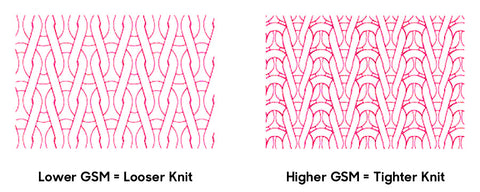When shopping for clothing or looking at some of the more amoure product descriptions you may have come across the term "GSM" mentioned in product descriptions or labels. But what exactly does GSM mean, and why is it important? In this article, we'll demystify GSM in clothing, explaining what it stands for, how it's measured, and why it matters when it comes to fabric weight and quality.
SO WHAT IS GSM?
GSM stands for "Grams per Square Meter," and it refers to the weight of a fabric per square meter of area. In general, GSM measures how dense or heavy a piece of fabric is, with higher GSM values indicating thicker and heavier fabrics, and lower GSM values indicating lighter and thinner fabrics. Denim will have a higher GSM than silk for example.
How is GSM Measured?
GSM is typically measured using a specialized tool called a GSM cutter and a precision balance scale. To determine the GSM of a fabric, a sample of known area (usually 10cm x 10cm) is cut from the fabric and weighed on the scale. The weight of the sample is then divided by the area of the sample to calculate the GSM value.

Why Does GSM Matter?
GSM is an important indicator of fabric weight, thickness, and quality, and it can have a significant impact on the look, feel, and performance of a garment. Here are a few reasons why GSM matters in clothing:
Fabric Quality: GSM is often used as a measure of fabric quality, with higher GSM fabrics generally considered to be of better quality and durability. Fabrics with higher GSM values tend to be more substantial, less transparent, and better able to withstand wear and tear over time.
Comfort and Performance: The GSM of a fabric can also affect its comfort and performance characteristics. Lighter GSM fabrics are often more breathable and flexible, making them ideal for warm weather or active wear, while heavier GSM fabrics offer greater warmth, insulation, and structure, making them suitable for colder climates or structured garments.
Design and Aesthetics: GSM can also impact the drape, texture, and appearance of a garment. Fabrics with lower GSM values may have a softer, more fluid drape, while fabrics with higher GSM values may have a stiffer, more structured drape. Designers often choose fabrics with specific GSM values to achieve the desired look and feel for their designs.

GSM is a key measurement in the world of clothing and textiles, providing valuable information about fabric weight, thickness, and quality. By understanding GSM and its implications, consumers can make more informed choices when shopping for clothing, selecting fabrics that meet their preferences for comfort, performance, and style. Whether you're looking for a lightweight summer dress or a cozy winter sweater, paying attention to GSM can help ensure that you find the perfect fabric for your needs.

